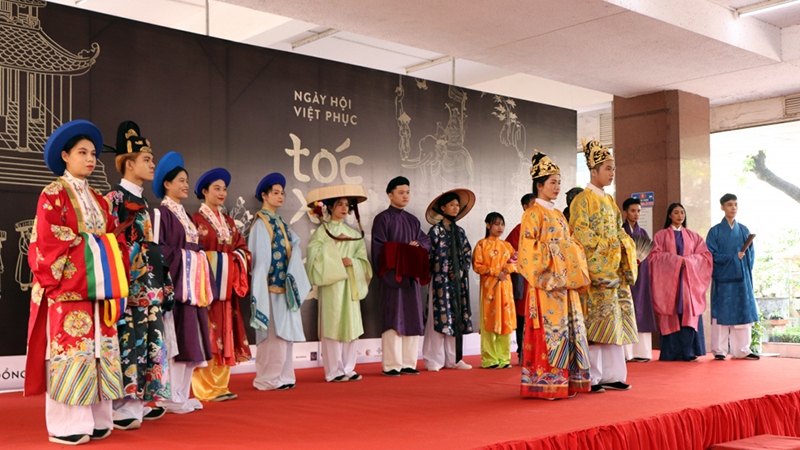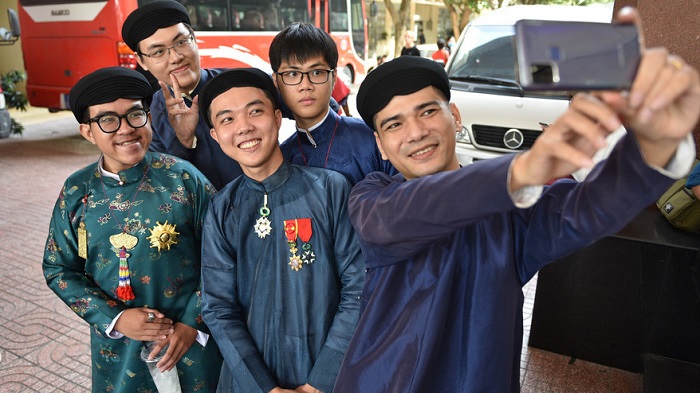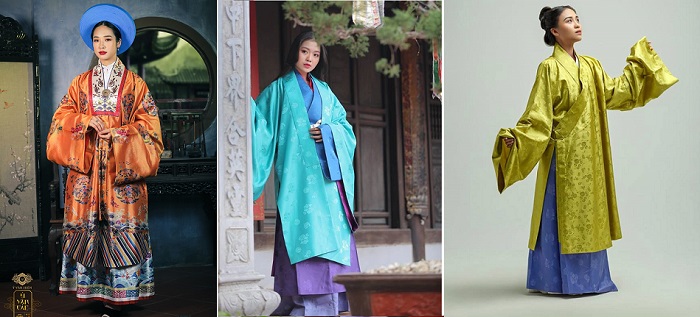Although efforts have been made in terms of the research and restoration of Vietnamese traditional and ancient costumes for a long time, it wasn’t until recent years that the costumes have gained increased favour and appreciation from the public, particularly amongst young people.

Traditional Vietnamese costumes introduced to students at a cultural week held in January 2021 by the Youth Union of the University of Social Sciences and Humanities in Ho Chi Minh City (Photo: NDO/Tan Dong)
Starting from being featured at museums, in historical documents and documentary films, ancient Vietnamese attire is now to be seen at a wide range of cultural and arts activities. The wearing of the costumes has even become a prominent fashion trend in 2020 and is predicted to be further promoted in the coming years.
A welcome comeback
Last year, images of artists, students and young couples wearing Ao dai ngu than (five-flap long dress), the Giao Linh costume (cross-collared robe) and the Nhat Binh costume (square-collared garb) at entertainment events, art performances, outdoor activities, trips, and weddings were seen on social networks and in the media. That young people show such an interest in ancient Vietnamese costumes is an encouraging sign after a long period when the costumes had fallen into oblivion and were equated with the clothing of other Asian countries.
Costume is an important part of traditional art; however, it is also a difficult research field since it was rarely mentioned in historical documents. Dozens of years ago, several academic studies were conducted, including Professor, Dr. Doan Thi Tinh’s research on Vietnamese costumes, researcher Trinh Bach’s thesis on royal costumes, and researcher Trinh Quang Vu’s study of costumes from the Vietnamese feudal dynasties.
Since 2014, online communities, forums and groups on Vietnamese customs, culture, and costumes have been established, attracted numerous members, mostly young people. Prominent among them include Dai Viet Co Phong and Dinh Lang Viet, whose projects on revitalising ancient Vietnamese costumes have brought about positive results amongst the youth.
In mid-January 2021, the Youth Union of the University of Social Sciences and Humanities in Ho Chi Minh City held a cultural week, gathering the participation of 12 groups on ancient culture. The event featured exhibitions and performances of traditional Vietnamese costumes through various historical periods such as the Ao dai (traditional long dress), Ao dai ngu than (five-flap long dress), Giao Linh costume (cross-collared robe), Vien Linh (round-collared dress) and Nhat Binh costume (square-collared garb) as well as accessories such as hats, shoes, and fans in gorgeous, eye-catching colours and styles.
Thousands of visitors to the event had the opportunity to learn more about the ancient attire, try on the outfits, and admire re-enactments of royal rites.
According to Dr Le Thi Ngoc Diep, a lecturer at the university, the event aimed to promote Vietnam’s treasured heritage to young people, who will play the leading role in preserving and promoting cultural values in the future.
Also in early 2021, the Vietnam Centre – a non-profit organization with the mission of promoting the culture and image of Vietnam to the world, released a video titled ‘1000 Years of Vietnamese Fashion’ on its YouTube channel.
The three-minute video, which has received more than 300,000 views, tells how traditional Vietnamese fashion transformed over the 1000 years from the Ly Dynasty (11th century) to the Nguyen Dynasty (late 20th century). The production crew also posted pictures of each outfit with explanations and their historical basis, in both Vietnamese and English on its official Facebook page.
In addition, ancient Vietnamese attire has been featured in a series of historical films, music videos, and projects which have increased public interest in traditional culture, including an animated film based on a historical theme entitled 'Binh Ngo Dai Chien' (The Pacification of the Wu), a bilingual book on Vietnamese costumes in the 15th century entitled ‘Det Nen Trieu Dai’ (Weaving A Realm), the comic 'Truyen Thuyet Long Than Tuong' (Legend of the Dragon General), and the Hoa Van Dai Viet (Patterns of Great Viet) project.

Students in traditional Ao Dai for men take a wefie with their cell phone (Photo: tuoitre.vn)
Promoting ancient attires in modern life
According to painter Nguyen Duc Binh, chairman of the Dinh Lang Viet, as Vietnam is strongly integrating into the world in all aspects in the current context of global cultural exchanges, it is necessary to build a distinct image which can help Vietnam affirms its tradition.
Besides functional agencies of the cultural sector, independent associations and groups have many advantages in conducting research and restoration activities through use of technology and crowdfunding.
In addition to domestic data sources, young researchers with certain foreign language skills can make reference to foreign historical documents about Vietnamese attires. Tran Quang Duc, author of the book ‘Ngan Nam Ao Mu’ (Thousand years of Caps and Robes), spent three years collecting information and references from documents in Nom scripts (Chinese transcribed Vietnamese), as well as in Chinese, Korean and Japanese in order to provide readers with a comprehensive overview of Vietnamese ancient costumes.
Born in 1990, Nguyen Duc Loc, the founder of the ancient clothing brand Y Van Hien, is a designer who is famous among the communities on ancient costumes. He shared that in order to carry out clothing projects on reproducing ancient costumes, his team must dig through hundreds of pages of documents, and then compare what’s described in the texts with paintings and sculptures at museums, monuments, and temples.
The team members also have to visit craft villages of weaving, embroidery, and jewellery to collect documents and witnesses on the making of costumes in the past. The reproduction process requires a lot of effort, money and time, particularly the costumes of kings, mandarins, and concubines in the feudal dynasty.
“The more we research ancient costumes, the more we can recognise the quintessence of our country and the craftsmanship of our ancestors,” Loc said, adding that from materials to the patterns in ancient Vietnamese outfits still meet all the needs of people at present.
However, when ancient clothes are brought closer to the public, they can generate mixed opinions and misunderstandings among them. According to Ton That Minh Khoi, 24, who is the founder of Thien Nam Dai Lich Hau Phi Group, many Vietnamese people assume that traditional Vietnamese costumes only include Ao dai and the four-flap long dress, and they claim that other outfits such as Doi Kham (a type of jacket with an open centre front and parallel side fronts), Giao Linh are modified versions of the ancient costumes of China and the Republic of Korea.
“We want to organise more activities and event to popularise the diversity and richness of Vietnamese attires in different historical periods as well as the cultural interference in costumes,” Khoi said.
The promotion of ancient costumes in modern life not only helps Vietnamese people have a deeper understanding of traditional patterns and motifs but also contributes to preserving and upholding a number of traditional craft villages which are on the brink of extinction, including the embroidery villages of Quat Dong and Dong Tu, and Van Phuc Silk Village in Hanoi, Nha Xa Silk Village in Ha Nam Province, and Ma Chau Silk Village in Quang Nam Province.

From left: Nhat Binh costume (square-collared garb), Doi Kham (a type of jacket with an open centre front and parallel side fronts), Giao Linh costume (cross-collared robe).
Hai Lam
















